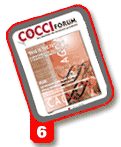COCCI Views
Blending nutrition into coccidiosis management
 |
For an old disease, coccidiosis
sure inspires a lot
of innovation. The focus
used to be containing
coccidia with in-feed
anticoccidials. It didn't
seem particularly complicated.
Now we're faced
with anticoccidial resistance,
a shrinking pool of
in-feed anticoccidials and a demand for more naturally
raised birds "all at a time when competition is tough
and economic pressures are high.
More poultry integrators are realizing that to achieve
effective coccidiosis control, careful consideration must
be given to the methods used, the time of year and
length of time they are given. There's no doubt that coccidiosis
control has gotten more complicated. I predict,
however, that as experience is gained with newer
approaches, the learning curve will minimize and the
efforts will prove to be worthwhile.
Take the case of Wayne Farms in Georgia, the sixth
largest vertically integrated processor in the US. Ten
years ago or so, they planned their anticoccidial usage on
a 6-month basis. Now they plan about 2 to 3 years ahead.
As Wayne's Dr. Don Waldrip puts it in the article that
begins on page 4, "You need to position certain anticoccidials
by time of year, by length of usage, by loss of sensitivity
and other factors. The decision-making process
on the use of coccidiostats has become more involved.
Deciding which anticoccidial to use and what frequency
is increasingly more important."
Now that's innovation.
Further novel approaches to coccidiosis control are
likely to come as scientists learn more about the Eimeria
parasites that cause coccidiosis. In the UK, well-known
parasitologist Dr. Martin Shirley says that despite progress
in the field of coccidiosis, little is actually known about
the biology of Eimeria parasites. Many of the answers lie
in the genetic code of the organisms, which Shirley and
other scientists are studying.
In fact, Dr. Shirley and colleagues have secured a
grant to study the DNA sequence for the Houghton strain
of E. tenella. The resulting "blueprint" is expected to
reveal 90% of the parasite's encoded proteins. That in
turn should bring about a greater understanding of key
information, such as how Eimeria parasites cause disease
and how they elicit an immune response. Data from the
project, which will be made available to the public on
the Internet, will help parasitologists identify new targets
for vaccination and chemotherapy. Be sure to read more
about these innovations in the article that begins on page
10.
In the meantime, the Poultry Technical Service Team
at Schering-Plough Animal Health continues to broaden
its expertise in coccidiosis control, while helping to hatch
more innovation in the field. With sound science as the
foundation, we plan to provide cutting-edge products to
the poultry industry and continue our close association
with poultry producers to help ensure the products they
buy and use are as efficacious and cost-effective as possible.
We'll keep you posted of new advances through
personal calls, meetings, technical bulletins and, of
course, future issues of CocciForum.
Rick Phillips, DVM, MAM, Diplomate ACPV
Worldwide Director of Technical Services
Poultry Business Unit
Schering-Plough Animal Health Corporation
Source: CocciForum Issue No.6, Schering-Plough Animal Health.










